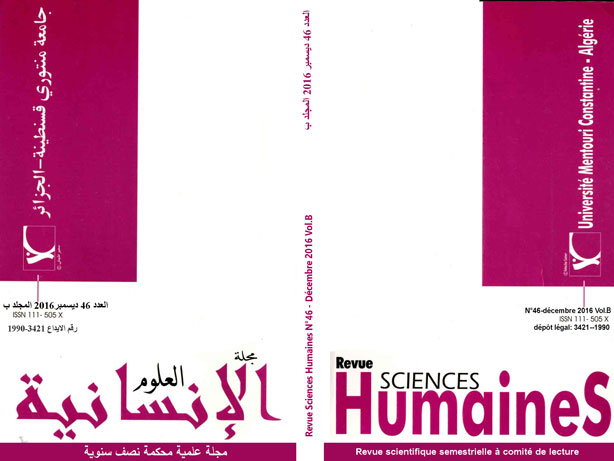Teaching English Oral Expressionand Listening Comprehension at the Department ofLetters and English Language, University of Constantine 1: Past and Present Ups and Downs
الكلمات المفتاحية:
Audio-lingual method، functional approach، language laboratory، language skills، language teaching، listening comprehension، pronunciation، syllabus design، situational Englishالملخص
This paper gives an overview of how Oral Expression and Listening Comprehension have been taught at the Department of English, University of Constantine, ever since the early eighties to the present time in the new LMD system. It provides a critical analysis of the official syllabi of the classical system and that suggested in the current LMDsystem. Then, it contrasts them with the reality of such teaching at the department. This analysis helps determine the shortcomings of each of the two systems. It also suggests some solutions for a more practical teaching of these two crucial skills in a pedagogical context characterized by ever decreasing linguistic and cultural levels and more and more overcrowded classes.التنزيلات
المراجع
Allen, J. P. B. (1984). General-purpose language teaching: a variable focus approach. ELT Documents 118/ 61-74. London: PergamonPress
Baril, D. & Guillet, J., (1969), Techniques de l’expression écrite et orale, Sirey.
Bizzell, P., (1989). Review of the book “The Social Construction of Written Communication”. College Composition and Communication 40, 483–486.
Beghoul, Y., (2007). The Interlanguage Phonology of the Undergraduate Students of English at the Department of English, University of Constantine.Unpublished Doctoral Thesis.University of Constantine 1
Blau, E. K. (1990). The effect of syntax, speed, and pauses on listening comprehension. TESOL Quarterly, 24, 746-53.
Boyle, J. (1984). Factors affecting listening comprehension.ELT Journal, 38(41):34-38.
Brown, G. (1995). Dimensions of difficulty in listening comprehension. In D. Mendelshon& J. Rubin, (Eds.), A Guide for the Teaching of Second Language Listening (pp. 59-73). San Diego: Dominie Press.
Brust, M. R, Adriano, C. M, and Ricarte I. M. L. (2007).Redesigning Computer-based Learning Environments: Evaluation as Communication.International Conference on Education and Information Systems.http://arxiv.org/abs/0706.1127
Chiang, Ch. S., &Dunkel, P. (1992). The effect of speech modification, prior knowledge, and listening proficiency on EFL lecture learning. TESOL Quarterly, 26, 345-374.
Conrad, L. (1989). The effects of time-compressed speech on native and EFL listening comprehension.Studies in Second Language Acquisition 11:1-16.
Contenu des Modules, a syllabus outline suggested by the Algerian Ministry of Higher Education and Scientific Research in the form of a handout printed in the late 1970’s.
Crystal, D. (1980). A first Dictionary of Linguistics and Phonetics, André Deutsch Limited.
Flowerdew, J. & Miller, L. (1992).Student Perceptions, problems and strategies in second language lectures.RELC Journal, 23/ 2:60-80.
Griffiths, R. (1992). Speech rate and listening comprehension: Further evidence of the relationship. TESOL Quarterly, 26 (2), 385-390.
Halliday, M.K., (1978). Language as Social Semiotic. Edward Arnold, London.
Henrichsen, L. E. (1984). Sandhi-variation: A filter of input for learners of ESL.
Language Learning, 34, 103-126.
Jason S. W, Richmond V. P., Gorhan J., (2001) Communication, Affect and Learning in the Classroom.Book on Demand, Miami.
Johns, T.F, & A. Dudley-Evans. (1980). An experiment in team-teaching of overseas postgraduate students of transportation and plant biology. Team Teaching in ESP (ELT Documents 106: 6-23). London: The British Council.
Long, D. R. (1990). What you don't know can't help you: An exploratory study of background knowledge and second language listening comprehension. Studies in Second Language Acquisition, 12, 65-80.
Lynch, T. (1997). Life in the slow lane: Observations of a limited L2 listener. System 25, 385-393.
Matter, J. (1989). Some fundamental problems in understanding French as a foreign language. In: Dechert, H.W. and Raupach, M. (eds.) Interlingual Processes. Gunter Narr, Tübingen, 105-119.
Markham, P. L., & Latham, M. (1987).The influence of religion-specific background knowledge on listening comprehension of adult second language students.Language Learning, 37, 157-170.
Richards, J. C. & Schmidt, R. (2002).Longman Dictionary of Language Teaching and Applied Linguistics, Third Edition, Longman.
Tinkler, T. (1980).Learning to teach listening comprehension.English Language Teaching Journal, v35 n1 p28-34
Zhao, Y. (1997). The effects of listeners’ control of speech rate on second language comprehension, Applied Linguistics, 18/1: 49-68.
















